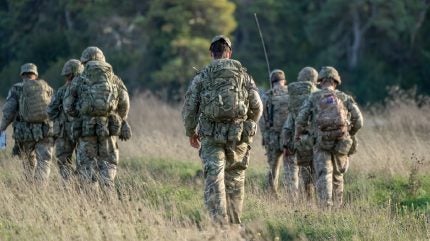
The British Army has under 19,000 personnel who are trained and medically able to be deployed in a combat role without limitations, according to new figures released by the UK government, with the numbers representing a new five-year low.
Released on 8 November, the UK Ministry of Defence (MoD), in a publications of combat deployable troops across the three main services, that the British Army had just 18,398 personnel who were listed as being Medically Fully Deployable (MFD), according to the military’s medical deployability standard, as of 1 July 2024.
This is down by more than 1,000 personnel compared to the 19,489 who met the MFD standard at the same period in 2023. A total of 21,488 troops were listed as being MFD in a combat role as of 1 July 2021.
Combat-role deployable British Army personnel

Even when including British Army serviceman and servicewomen who meet the Medically Limited Deployable (MLD) standard, of which 2,123 were categorised, the combined number of MFD and MLD troops able to be deployed into a combat role was just 20,521 personnel.
This too represents a four-year low, with the number of those categorised as MLD or MFD and able to be deployed into a combat role in 2021 standing at 23,762 personnel.
For the British Army, the figures reflect the MDS of full-time trade trained strength of the Infantry, the Household Cavalry and Royal Armoured Corps and the Army Air Corps only, which are defined by the service as personnel serving in a ‘combat role’.
The figures include Reserve Forces personnel filling regular posts whilst serving on full time reserve service and Gurkha personnel.
Can the British Army deploy a combat division?
The British Army’s ability to deploy a warfighting division, as per its commitment to Nato, has been called into question in recent years as persistent cuts and recruitment difficulties has seen it reduce to just over 74,000 regular, full-time, personnel.
The service is also shedding over 1,500 armoured and protected vehicles through to 2030, with the out of service dates (OSD) of the Stormer, Cougar-series, Foxhound, and Bulldog all on the horizon, amid a once-in-a-generation reordering of its force structure.
In addition, the British Army has also dispensed with most of its 155mm artillery capability through donations of the AS90 self-propelled howitzers (SPH) to Ukraine, only procuring an interim 14 Archer 155mm SPHs as a stop gap measures. The future RCH 155 SPH will likely only be delivered towards the end of the decade.
The numbers of Challenger 2 main battle tanks are also extremely limited, with 213 vehicles left in service as of the end of Q1 2024. Only 148 of these are on contract to be upgraded to the improved Challenger 3 standard.
It was reported by Army Technology in August 2023 that the service had just 157 Challenger 2 tanks available for operations out of a paper fleet of 227 vehicles, with platforms reduced to be cannibalisation for spares.
Procurement efforts for platforms such as the Boxer mechanised infantry vehicle and Ajax armoured fighting vehicle have been hit by numerous delays, forcing the service to extend the use of platforms that are due to be retired.
The parlous state of the British Army has seen erstwhile allies such as the United States publicly questions the UK’s ability to contribute an effective force towards Nato operations, in the event of open conflict.



